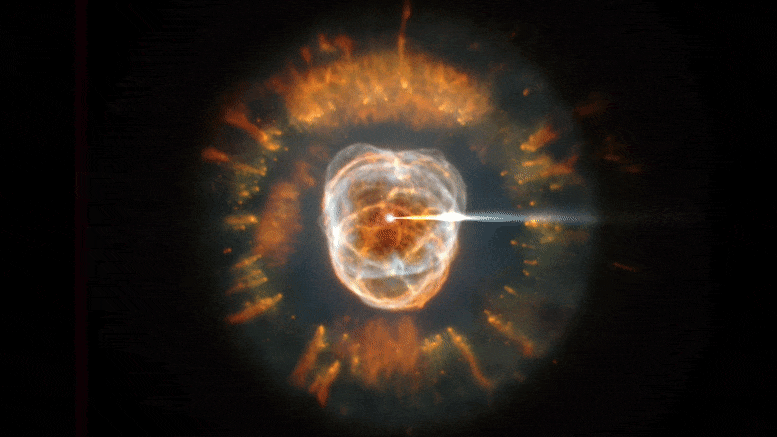Hear the Eerie Sounds of Nebula NGC 2392
NGC 2392 is a bipolar double-shell planetary nebula.
About 5,000 light-years from Earth, the stunning nebula NGC 2392 formed after the demise of a star like our Sun.
In this sonification, the image is scanned clockwise like a radar. The radius is mapped to pitch, so light farther from the center is higher pitched. The outline of the nebula’s shell can be heard in the rising and falling of pitch, punctuated by its spokes. Brightness controls the volume.
Sonification credit: SYSTEM Sounds (M. Russo, A. Santaguida)
NGC 2392, known as the Eskimo Nebula, Clown-faced Nebula, Lion Nebula, or Caldwell 39, is a double-shelled planetary nebula, with the more distant gas having composed the outer layers of a Sun-like star only 10,000 years ago. The outer shell contains unusual light-year-long orange filaments. The visible inner filaments are being ejected by a strong wind of particles from the central star. The NGC 2392 Nebula spans about 1/3 of a light year and lies in our Milky Way Galaxy, about 3,000 light years distant from Earth, toward the constellation of the Twins (Gemini).
To some, the huge NGC 2392 nebula resembles a person’s head surrounded by a parka hood, hence the Eskimo Nebula nickname. In 1787, astronomer William Herschel discovered this unusual planetary nebula. More recently, the Hubble Space Telescope imaged the nebula in visible light, while the nebula was also imaged in X-rays by the Chandra X-ray Observatory. The featured combined visible-X ray image, shows X-rays emitted by central hot gas in pink. The nebula displays gas clouds so complex that they are not fully understood.

NGC 2392 is a bipolar double-shell planetary nebula.
About 5,000 light-years from Earth, the stunning nebula NGC 2392 formed after the demise of a star like our Sun.
In this sonification, the image is scanned clockwise like a radar. The radius is mapped to pitch, so light farther from the center is higher pitched. The outline of the nebula’s shell can be heard in the rising and falling of pitch, punctuated by its spokes. Brightness controls the volume.
Sonification credit: SYSTEM Sounds (M. Russo, A. Santaguida)
NGC 2392, known as the Eskimo Nebula, Clown-faced Nebula, Lion Nebula, or Caldwell 39, is a double-shelled planetary nebula, with the more distant gas having composed the outer layers of a Sun-like star only 10,000 years ago. The outer shell contains unusual light-year-long orange filaments. The visible inner filaments are being ejected by a strong wind of particles from the central star. The NGC 2392 Nebula spans about 1/3 of a light year and lies in our Milky Way Galaxy, about 3,000 light years distant from Earth, toward the constellation of the Twins (Gemini).
To some, the huge NGC 2392 nebula resembles a person’s head surrounded by a parka hood, hence the Eskimo Nebula nickname. In 1787, astronomer William Herschel discovered this unusual planetary nebula. More recently, the Hubble Space Telescope imaged the nebula in visible light, while the nebula was also imaged in X-rays by the Chandra X-ray Observatory. The featured combined visible-X ray image, shows X-rays emitted by central hot gas in pink. The nebula displays gas clouds so complex that they are not fully understood.
